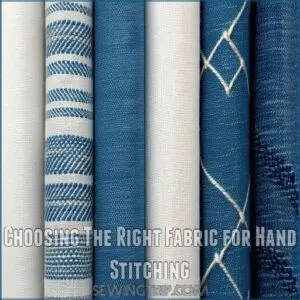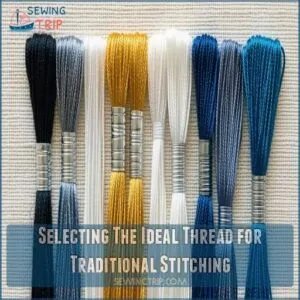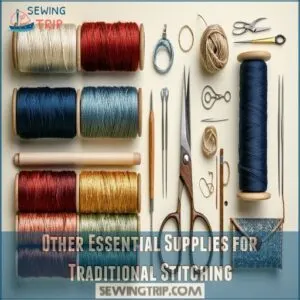This site is supported by our readers. We may earn a commission, at no cost to you, if you purchase through links.
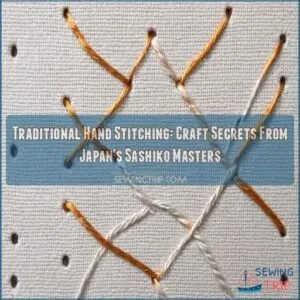 Traditional hand stitching patterns, like Japan’s sashiko, blend utility and beauty, creating intricate designs with simple yet artful stitches.
Traditional hand stitching patterns, like Japan’s sashiko, blend utility and beauty, creating intricate designs with simple yet artful stitches.
Sashiko’s geometric patterns, such as diamonds and circles, often use running stitches to form mesmerizing, continuous lines.
Historically, this stitching was functional, reinforcing fabric during the Edo period, but it evolved into a treasured art.
To start, you’ll need medium-weight linen, heavy cotton thread, and sashiko needles. Consistent tension and even stitches are key, so practice rocking motions for precision.
These patterns aren’t just decoration—they’re a glimpse into cultural heritage.
Curious about mastering curves or advanced designs? There’s a method to everything.
Table Of Contents
Key Takeaways
- You can start with sashiko techniques, using simple running stitches to create striking geometric patterns that blend beauty and utility.
- Choose medium-weight linen fabric, heavy cotton thread, and sashiko needles to ensure precision and durability in your projects.
- Focus on consistent tension and even stitches to avoid common mistakes and create polished, professional-looking designs.
- Traditional hand stitching isn’t just decorative; it’s a meditative practice that connects you to cultural heritage and the art of storytelling through fabric.
Traditional Hand Stitching Patterns Explained
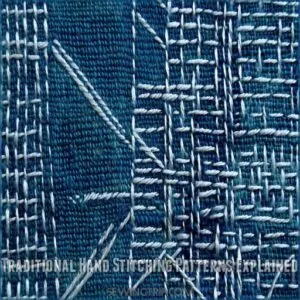
You’ll discover the artistry of traditional hand stitching through its mesmerizing geometric patterns that transform simple threads into intricate storytelling designs.
As you explore sashiko techniques, you’ll learn how Japanese masters use precise running stitches to create breathtaking geometric patterns that elevate mending and decoration to an extraordinary craft.
Definition of Traditional Hand Stitching
Traditional hand stitching is an intricate needlework technique that transforms simple threads into breathtaking geometric patterns.
It’s more than just connecting fabric – it’s a storytelling art form passed down through generations.
Sashiko, a Japanese method, uses precise running stitches to create stunning designs that blend functionality with incredible visual beauty, turning ordinary textiles into extraordinary masterpieces.
Brief History of Traditional Hand Stitching
Let’s explore the rich tapestry of sashiko’s origins, which weaves together necessity and artistry.
Emerging during Japan’s Edo period, this hand stitching technique began as a practical solution for peasant farmers and fishermen seeking to reinforce and mend worn clothing.
What started as a survival skill gradually transformed into an intricate art form, preserving cultural heritage through every carefully placed stitch. Sashiko’s origins blend necessity and artistry.
Types of Traditional Hand Stitching Patterns
As you unravel the rich tapestry of hand stitching, you’ll discover a world of intricate patterns that breathe life into fabric. Each stitch tells a story, weaving cultural heritage into thread.
- Running stitch: The foundational heartbeat of needlework
- Backstitch: A secure embrace connecting fabric layers
- Blanket stitch: Decorative edges that dance with purpose
- Overstitch: Protective borders guarding textile integrity
- French Knot: Playful embellishments that add visual poetry
Hand quilters can use traditional western stitching techniques for subtle texture and design with regular thread.
These patterns transform simple threads into extraordinary textile art.
Basic Tools and Supplies Needed
You’ll need a carefully curated set of tools to master traditional hand stitching.
Starting with medium-weight linen fabric, heavy cotton threads, and long darning needles.
Your essential kit should include sashiko needles, a thimble, fabric scissors, and marking tools like water-soluble pens.
to help you create precise, beautiful geometric patterns with confidence.
Choosing The Right Fabric for Hand Stitching
When mastering sashiko, your fabric choice can make or break the project.
Medium-weight linen or cotton/linen blends work best, offering the perfect canvas for intricate hand stitching patterns.
Steer clear of dense fabrics like denim or twill—they’ll fight your needle every stitch of the way. Look for loose weaves that welcome your creative touch.
For inspiration and a wide selection of suitable fabrics, explore linen hand stitching fabric to find the perfect match for your project.
Selecting The Ideal Thread for Traditional Stitching
You’ll want to explore traditional sashiko threads that pack a punch.
Choose heavier embroidery threads like 6-strand floss or size 8 pearl cotton to bring your designs to life.
White cotton thread remains the classic choice, offering durability and crisp definition.
Your thread selection can make or break the intricate geometric patterns that define this timeless Japanese craft.
Recommended Needles for Hand Stitching Patterns
After choosing your thread, selecting the right needle becomes your next craft companion.
Your needle choice impacts stitch quality, so invest time in finding the perfect match for your sashiko project‘s unique rhythm and style.
Master sashiko hand stitching with these needle types:
- Long darning needles for smooth geometric lines
- Milliners’ needles with oval eyes for precision
- Blunt-tipped needles preventing fabric snags
Other Essential Supplies for Traditional Stitching
Beyond needles and thread, your sashiko journey demands a few strategic tools.
Check out this essential toolkit breakdown:
| Supply Category | Items |
|---|---|
| Marking Tools | Watersoluble marking, chalk paper |
| Cutting Tools | Fabric scissors, stitch ripper |
| Protection Tools | Thimbles, darning needle case |
Proper storage keeps your embroidery fiddle-free and your creative spirit unbroken. Effective storage is key to a stress-free crafting experience.
Effective organising sewing supplies can also help you work more efficiently and reduce clutter in your crafting space, allowing you to focus on your sashiko stitching and enjoy the process.
Traditional Hand Stitching Techniques
Learn the art of traditional Japanese hand stitching by mastering the simple running stitch.
This fundamental technique will transform your fabric into a canvas of geometric beauty.
You’ll discover how to create continuous lines, maintain even tension, and avoid common mistakes.
These mistakes can make your stitching look unpolished and amateurish.
The Simple Running Stitch in Traditional Stitching
Master the running stitch’s simplicity, and you’ll discover a world of textile creativity.
This fundamental hand stitching technique lets you weave stories through fabric with just up-and-down needle movements.
Practice creates rhythm – each pierce and pull transforms simple thread into functional art.
Even beginners can quickly learn this versatile stitch that bridges tradition and personal expression.
To get started, explore the basics of the running stitch tutorial.
Creating Geometric Patterns With Traditional Stitching
Geometric patterns bring life to traditional hand stitching. From diamonds to interlocking circles, sashiko patterns elevate fabric with balance and precision.
Focus on stitch density—keep spacing even for clean results.
Experiment with color choices, pairing indigo and cream, or mix hues for modern twists.
Lightweight linens or cottons work best, ensuring flexibility for intricate Japanese embroidery designs.
Working With Continuous Lines in Traditional Stitching
In traditional hand stitching patterns, working with continuous lines guarantees a smooth pattern flow and stitch consistency.
Opt for a running stitch to follow geometric patterns seamlessly. Maintain steady thread tension and avoid stopping mid-line.
For clean finishes, carry the thread through the fabric layers when possible.
Line variations, like curves or angles, create striking effects.
Tips for Even Stitching and Avoiding Mistakes
For consistent tension, focus on smooth, even motions when using the sashiko stitch or running stitch. Keep stitch length uniform, like grains of rice, and manage thread by clipping often to avoid tangles.
When working corners, avoid pulled stitches by leaving a touch of slack.
To achieve the best possible stitch quality, master the rocking motion, known as unshin technique.
Troubleshooting errors? Check alignment and spacing regularly—traditional hand stitching thrives on balance and precision.
Traditional Sashiko Patterns and Projects
You’ll find traditional sashiko patterns like cubes, diamonds, and overlapping circles offer both beauty and versatility for countless projects.
Start small with coasters or samplers, then explore larger creations like placemats or quilt blocks.
Traditional Sashiko Patterns for Beginners
Starting with sashiko patterns like Sankaku or Ajiro simplifies learning. Choose medium-weight linen fabric for easy stitching, and focus on consistent stitch tension resembling rice grains.
Handy for beginners, these geometric designs work well for coasters or samplers.
To master the traditional sashiko stitching technique, understanding the importance of even stitch size makes a big difference.
Make the learning process easier by practicing on small projects, avoiding tight stitches, and opting for white sashiko thread on dark fabric. Avoid tight stitches. Practice on small projects. Use white sashiko thread on dark fabric.
Adapting Sashiko Patterns for Other Embroidery Projects
Sashiko patterns aren’t just for traditional embroidery. You can use them to add flair to quilts, tote bags, or even wall art.
Try these ideas:
- Combine pattern variations with bold color choices for modern designs.
- Use modified sashiko designs on softer fabric choices like linen or muslin.
- Experiment with stitch modifications to suit diverse project ideas.
Creating Reversible Placemats and Coasters With Sashiko
With the right Sashiko pattern choices, crafting reversible placemats or coasters becomes accessible.
Focus on medium-weight linen for easy stitches and vibrant designs.
Stitch tension control is key—keep it consistent. Use clean finishing techniques like hidden finishing for seamless edges.
Experiment with project variations, combining Japanese embroidery patterns to create stunning, practical home accents using timeless hand stitching techniques.
For inspiration, explore reversible sashiko placemats to find unique designs and styles that suit your taste.
Using Sashiko Patterns for Quilting and Home Decor
Modern sashiko brings life to quilting and embroidered home decor.
Picture indigo-dyed fabric adorned with timeless sashiko patterns—cubes, diamonds, or overlapping circles—to craft quilts or accent cushions.
Sashiko variations, like hand-stitched samplers, add a Japanese folk embroidery flair to wall art.
Using a sashiko placemat as inspiration, you can reimagine these designs for elegant decor pieces brimming with texture and artistry.
Advanced Traditional Stitching Techniques
You’ll learn how to tackle intricate patterns.
These advanced methods require steady hands, careful tension control, and a focus on symmetry for flawless results.
and refine techniques for curves, angles, and straight lines with precision.
Creating Intricate Patterns With Traditional Stitching
Intricate patterns demand precision, so adjust your stitch density for textured effects.
Explore pattern variations like overlapping circles or boxed shapes, letting thread choices and color palettes elevate your design.
Combine the sashiko stitch with other hand embroidery patterns to add depth.
Focus on stitching techniques to balance traditional embroidery beauty with durability, creating standout project ideas that captivate.
Working With Curves and Angles in Traditional Stitching
Tackling curves and angles in traditional stitching requires patience and skill.
Use shorter needles for precision and maintain stitch tension to avoid puckering.
For curves, adapt geometric designs by marking smooth arcs; for angles, stitch to meet cleanly at points.
Practice creates mastery—experiment with sewing designs like fans or waves to refine your embroidery techniques and perfect your stitching designs.
Tips for Maintaining Even Tension in Traditional Stitching
Even tension starts with smart choices: pick a smooth thread, right needle, and even-weave fabric, such as traditional cotton fabric often used in Sashiko stitching patterns.
Use consistent stitch lengths across embroidery patterns.
Relax your grip, let the thread glide naturally, and avoid pulling too tight. Test stitching designs on scraps.
Steady hands, balance, and patience create flawless hand embroidery patterns and keep needlework patterns beautifully consistent. Practice makes perfect!
Troubleshooting Common Mistakes in Traditional Stitching
Uneven stitches or fabric puckering can ruin the flow of hand embroidery patterns. To avoid these pitfalls:
- Keep thread tension steady to prevent puckering.
- Resolve thread tangles by clipping and rethreading.
- Prevent knot issues by weaving thread ends neatly.
- Confirm alignment by tracing carefully and stitching lightly.
Invest in a quality sashiko embroidery kit to help master these techniques.
These stitching tips make sashiko embroidery projects stress-free!
Frequently Asked Questions (FAQs)
What is Sarah’s hand embroidery tutorials?
Sarah’s step-by-step guidance on various embroidery techniques makes her tutorials a valuable resource.
From basic stitches to intricate designs, her approachable style and detailed explanations make learning embroidery both enjoyable and rewarding.
Is sashiko stitching easy to learn?
Sashiko stitching is easy to learn with its simple running stitch and geometric patterns.
Start with small projects like coasters to practice.
Focus on even stitches and enjoy the meditative rhythm as you improve.
What stitch should I use for hand quilting?
Think of hand quilting as a rhythm—use the rocking stitch for smooth, even results.
Push the needle through all layers with a single motion, aiming for small, consistent stitches about the size of a rice grain.
What is a straight stitch?
A straight stitch is the simplest sewing technique where you sew in a straight line, moving the needle in and out of the fabric.
It’s versatile, great for seams, hems, and decorative handwork.
Is Sashiko a meditative hand stitch?
Ever feel like you need a break from the hustle?
Sashiko stitching is deeply meditative, connecting your hands and mind through simple, rhythmic patterns.
It’s calming, creative, and a perfect way to slow down.
What is a Sashiko pattern?
A Sashiko pattern is a traditional Japanese embroidery design.
It features geometric shapes and repetitive motifs like diamonds, circles, or triangles.
It emphasizes symmetry and simplicity.
functional beauty creating intricate textures while reinforcing fabric.
What are the four basic hand stitching?
Like the foundation of a sturdy house, the four basic hand stitches are the running stitch for simple seams.
backstitch for strength.
whipstitch for edges.
and blanket stitch for decorative finishes or reinforcement.
What is the strongest hand stitch pattern?
The strongest hand stitch is the backstitch.
It creates a solid, overlapping line of stitches, making it durable for seams or repairs.
Use it for areas under stress, like garment openings, to prevent tearing.
What are the 10 basic stitches?
Mastering the 10 basic stitches—running, back, whip, cross, chain, satin, split, blanket, French knot, and lazy daisy—sets you up for versatile hand sewing and embroidery.
This opens up countless creative possibilities.
These possibilities are in fabric projects.
What are the 12 stitches?
Did you know 90% of hand-stitched designs rely on basic stitches?
Learn these essentials: running stitch, backstitch, whipstitch, satin stitch, chain stitch, lazy daisy, French knot, cross-stitch, blanket stitch, fly stitch, feather stitch, and seed stitch.
Conclusion
Mastering traditional hand stitching patterns is like weaving together threads of history and creativity.
With sashiko, you’re not just stitching fabric—you’re connecting to centuries of Japanese craftsmanship.
By using simple tools like sashiko needles and heavy cotton thread, you can create functional yet artful designs, from geometric patterns to intricate curves.
Practice precision, embrace the process, and watch your skills grow.
Whether you’re mending, decorating, or quilting, these stitches transform everyday projects into timeless works of art.
- https://www.youtube.com/watch?v=3GTBaCaNVww
- https://fthmb.tqn.com/Bo-mrg_6c3YuHzOJHoqjD3iGP-M=/CF_Sashiko1-56a28d483df78cf772776d9b.jpg
- https://www.pinterest.com/pin/272256739962732353/
- https://www.thesprucecrafts.com/sashiko-patterns-projects-and-information-1177510
- https://otherwiseamazing.com/sashiko-stitching-japanese-embroidery-with-free-pattern/

